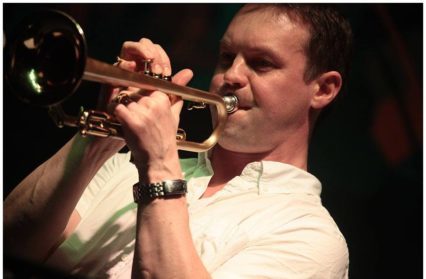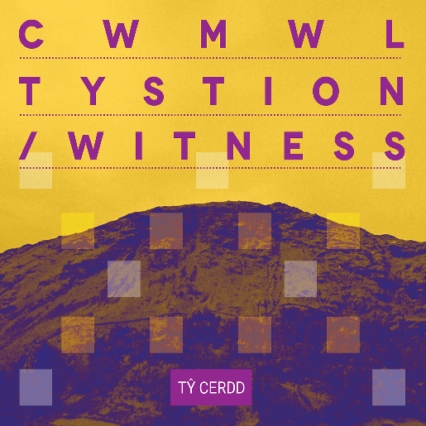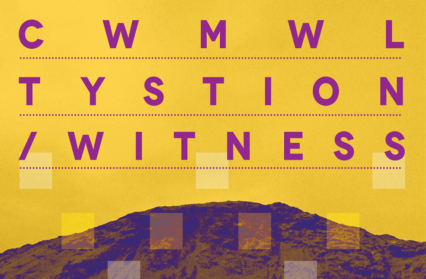Cwmwl Tystion / Witness is an experimental jazz album by Welsh composer and trumpeter Tomos Williams. The title is derived from a poem by Waldo Williams (1904-1971), in which the pacifist and nationalist confronts issues of identity. Nigel Jarrett finds a refreshing concept and timely illustration of how Welsh jazz is pushing boundaries in an international setting.
Jazz worldwide is treading water, now and then swimming off in different directions. It used to be more or less absolute music, referring to itself only in terms of love mostly unrequited, the controlled abandon of dance, or, in its Afro-American form, a burning existential anger. All that has changed, and what might once have been novelty is now serious exegesis. In the last year, to name but three, an Italian band has paid quirky homage to Verdi, a German one re-worked Schubert’s Winterreise, and a UK-Australian pianist transmogrified J. S. Bach under the influence of Miles Davis’s landmark album Kind Of Blue.

If there was jazz viewed in terms of patriotism, it was rarely more than a recognition that the musicians playing mainstream – that’s mainstream with a lower case ‘m’ – just happened to be from a particular country: Russia, for example, or the USSR as then was. It wasn’t Russian jazz; it was jazz played by Russians.
All the foregoing might be thought of as little more than inspired borrowing, as jazz musicians dissatisfied with day-to-day consolidation of an essentially restless form seek outside influences. One could not, however, take the music on this album for granted while welcoming its take on Welshness and nationalism. Trumpeter-composer Tomos Williams and his five colleagues (six if Simon Proffitt and his visual effects in live performance is included) have a free-wheeling approach to the elements of Welsh identity enshrined in the seven charts.
For Afro-American existentialism, read its Cymreig equivalent, as Williams creates music from a culmination of his ‘ideas, aspirations, and inspirations’ centred on Welsh history and culture and on the questions of who we are.
Explanatory statements in music don’t really explain much, least of all the references to things outside itself and the precise connection between the two. It’s worth mentioning this in terms of the opening and, at just over 21 minutes, longest track, ‘Mynyddoedd Cymru‘ (Mountains of Wales), described as ‘a celebration of the Welsh landscape’. Like most other jazz that sounds as though it’s being created on the hoof, this journey among the peaks is assiduously plotted. It falls into several sections in which a range of sonorities buffet, cajole, and support the principals. It begins earthbound with drummer Mark O’Connor’s drums and Huw V. Williams’s bass heading up the track before Rhodri Davies’s harp sidles up to the trumpet of Williams and Francesca Simmons’s violin falls back. Bass and drums continue their ascent. Pianist Huw Warren, ever buzzing mischievously throughout the proceedings, joins Simmons in a ritualistic dance, with Tomos Williams marking his presence at the end. The volume and tone subside to quieter, almost contemplative, string sounds, before trumpet and piano play catch-as-catch-can zapped by Davies’s electronic sheets of sound. O’Connor sets out for the last lap, Warren takes a look and decides it’s a path he can join with some enthusiasm, only for a repeated four-note figure on bass to usher in a brooding, Miles-like trumpet coda, succumbing with piano to the bass’s becalming step. These are weathered peaks whose uplands have a raw beauty and whose corresponding vales have spat fire.

The full personnel play on all other tracks bar ‘Glyn Tawe’, the folk-song performed by Simmons with Warren’s exquisite accompaniment wreathed about its line and following it into darker regions. Some of Mynyddoedd Cymru’s expansiveness is lavished on the second longest track, ‘Pa Beth yw Cenedl?’ (What Is A Nation?), a direct reference to the poem by Waldo Williams and incorporating three folk songs. As in every piece of music with extra-musical associations, this one might or might not lean towards parody. Williams’s trumpet intones a hymn-like proclamatory theme with elegiac tones above drums and then bass, which is joined by swirling piano and harp. Violin carries the mood forward. Musical forces gather for something more dramatic and riotous before Warren, bassist Williams and O’Connor race along in a ‘straight ahead’ jazz manner, eventually succumbing to that opening hymnal. An episode follows for transformed harp that would have been a cadenza if it did not arrive late and fritter into some crepuscular night.
‘Paul Robeson ac Eisteddfod y Glowyr 1957′ (Paul Robeson and the Miners’ Eisteddfod) is a joyous mélange set up by piano and harp into which is poured soaring and pizzicato violin, arco bass (maybe imitating Robeson’s coal-coloured baritone), and ostinato rumblings and mumblings. There’s a ponderous coda that suggests how Robeson’s appearance was significant, welcome, but one-off. Dissension pops up in ‘Llyfrau Gleision 1847’ (Blue Books 1847) and ‘Tryweryn 1965’: the first referring to the English attempt to wipe out use of the Welsh language in schools, and the second to the drowning of a Welsh village to provide reservoir water for areas of Wales and, controversially, Liverpool. ‘Llyfrau’ opens with a sustained rhythmic fusillade leading to a trumpet feature with raucous sidekick happenings, from wailing saw (Simmons) to explosive short-circuitings by Davies’s electronica (created by laying his electric mini-harp on its side and extracting fuzzy distortions from it with the use of sundry paraphernalia and amps). Warren takes over from trumpet for much agitation, anger, and confusion until the da capo rata-tat-tat and saw see us out. ‘Tryweryn’ is of similar cast, as violin charts lamentation and harp and piano introduce a deliciously liquid texture over which the violin continues its sad plaint before the waters close over. Some of the Blue-Book militancy may have been in order here to illustrate protest.
‘Pa Beth yw Dyn?’ (What is Man?) is answered in a brooding musical response from the composer. Davies the electro-gizmo chief sends a dark cloud across the path, and bass begins a trudge sprinkled with fairy-light piano touches before Warren extends this to an episode of warm, lyrical meandering with bass and drums, on which the movement ends. It is inspired: the composer is not there as trumpeter but he says farewell with a conventional jazz piano trio. It may be tempting in a furrowed-brow sense to match narratives and history with the music. It’s almost always unsatisfactory. Music illustrates little but itself. For a lively and inventive response to events, the Cwmwl Tystion suite says it all.
The band: Tomos Williams (composer, trumpet); Rhodri Davies (harp, electronics); Francesca Simmons (violin, saw); Huw Warren (piano); Huw V. Williams (bass); Mark O’Connor (drum kit).
Cwmwl Tystion / Witness is recorded on the Tŷ Cerdd label.
Nigel Jarrett writes and reviews for Jazz Journal magazine, and contributes a column called Count Me In. Based in Monmouthshire, he also writes on many subjects for Wales Arts Review. He is the winner of the Rhys Davies Prize and the Templar Shorts Prize for short fiction, and the author of three books of stories, a poetry collection, and a novel. In the last year, he has completed a second novel-type work of fiction, a second poetry collection, and a fourth collection of stories.
_______________________________________________________________________
Recommended for you:
100 Greatest Welsh Albums of All Time
Cwmwl Tystion / Witness Cwmwl Tystion / Witness



 Enjoyed this article? Support our writers directly by buying them a coffee and clicking this link.
Enjoyed this article? Support our writers directly by buying them a coffee and clicking this link.







